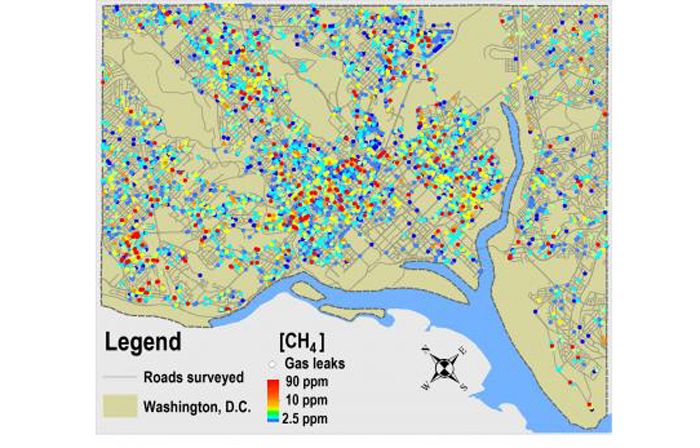Nearly 6,000 Natural Gas Leaks Found in Washington, D.C.

Aging pipelines under the streets of Washington, D.C., are to blame for nearly 6,000 natural gas leaks, including 12 that could have caused dangerous explosions, a new study finds.
Researchers from Duke University and Boston University mapped 1,500 road miles (2,400 kilometers) of underground infrastructure that delivers fuel to power homes and businesses in the nation's capital. Using a high-precision device to detect methane — the chief component of natural gas — the scientists discovered more than 5,893 natural gas leaks throughout the city.
The scientists also found some manholes with methane concentrations nearly 10 times greater than the threshold at which explosions can occur.
"Repairing these leaks will improve air quality, increase consumer health and safety, and save money," study lead author Robert Jackson, a professor of environmental sciences at Duke University, said in a statement. "Pipeline safety has been improving over the last two decades. Now is the time to make it even better."
After their initial findings, the researchers reported the leaks to city authorities. Yet, four months later, nine leaks were still found to be emitting dangerous levels of methane, Jackson said.
"Finding the leaks a second time, four months after we first reported them, was really surprising," he said.
Potent greenhouse gas
Sign up for the Live Science daily newsletter now
Get the world’s most fascinating discoveries delivered straight to your inbox.
Across the United States, pipeline failures cause an average of 17 deaths, 68 injuries and $133 million in property damage each year, according to the U.S. Pipeline and Hazardous Materials Safety Administration.
A 2010 explosion in San Bruno, Calif., that killed eight people highlighted the importance of pipeline safety. Some of the devastating fires that engulfed neighborhoods in the New York City area during Hurricane Sandy in October 2012 were also fueled by natural gas.
Yet natural gas leaks pose an additional threat: Methane is a powerful greenhouse gas, and natural gas leaks are the largest human-caused source of methane in the United States, the researchers said. (While methane is more powerful than carbon dioxide at trapping heat on a molecule-by-molecule basis, carbon-dioxide emissions and concentrations in the atmosphere are far higher than those of methane.)
The average concentration of methane observed from the leaky pipelines was about 2.5 times higher than in background air samples collected in Washington, D.C. In fact, some leaks were found to have methane concentrations as high as 89 parts per million, which is roughly 45 times higher than normal background air levels, the researchers said. That number means that for every 1 million air molecules, 89 are methane. [Greenhouse Gases: Biggest Emitters (Infographic)]
Jackson and his colleagues also measured the levels of methane coming from four individual street-level leaks.
"Methane emissions from these four leaks ranged from 9,200 to 38,200 liters [2,400 to 10,000 gallons] per day for each leak — that's comparable to the amount of natural gas used by between two and seven homes," Adrian Down, a Ph.D. student at Duke University, said in a statement.
Boston vs. Washington
Last year, the researchers made similar underground maps of the city of Boston, and detected more than 3,300 natural gas leaks.
"The average density of leaks we mapped in the two cities is comparable, but the average methane concentrations are higher in Washington," Nathan Philips, a professor in the Boston University Department of Earth and Environment, said in a statement.
The detailed findings of the study were published this week in the journal Environmental Science & Technology.
Follow Denise Chow on Twitter @denisechow. Follow LiveScience @livescience, Facebook & Google+. Original article on LiveScience.

Denise Chow was the assistant managing editor at Live Science before moving to NBC News as a science reporter, where she focuses on general science and climate change. Before joining the Live Science team in 2013, she spent two years as a staff writer for Space.com, writing about rocket launches and covering NASA's final three space shuttle missions. A Canadian transplant, Denise has a bachelor's degree from the University of Toronto, and a master's degree in journalism from New York University.










